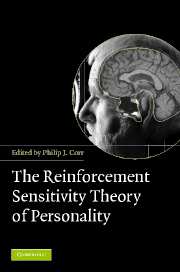Book contents
- Frontmatter
- Contents
- List of abbreviations
- List of figures
- List of tables
- List of contributors
- Preface
- 1 Reinforcement Sensitivity Theory (RST): introduction
- 2 The neuropsychology of fear and anxiety: a foundation for Reinforcement Sensitivity Theory
- 3 Animal cognition and human personality
- 4 The behavioural activation system: challenges and opportunities
- 5 Reinforcement Sensitivity Theory and personality
- 6 Reinforcement sensitivity scales
- 7 Performance and conditioning studies
- 8 Psychophysiological studies
- 9 Reinforcement Sensitivity Theory and mood induction studies
- 10 Neuro-imaging and genetics
- 11 Reinforcement Sensitivity Theory and psychosomatic medicine
- 12 RST and clinical disorders: anxiety and depression
- 13 RST and psychopathy: associations between psychopathy and the behavioral activation and inhibition systems
- 14 Behavioural activation and inhibition in social adjustment
- 15 Reinforcement sensitivity in the workplace: BIS/BAS in business
- 16 Formal and computational models of Reinforcement Sensitivity Theory
- 17 Reinforcement Sensitivity Theory: a critique from cognitive science
- 18 The contribution of Reinforcement Sensitivity Theory to personality theory
- General Index
- Index of Names
- References
11 - Reinforcement Sensitivity Theory and psychosomatic medicine
Published online by Cambridge University Press: 31 January 2011
- Frontmatter
- Contents
- List of abbreviations
- List of figures
- List of tables
- List of contributors
- Preface
- 1 Reinforcement Sensitivity Theory (RST): introduction
- 2 The neuropsychology of fear and anxiety: a foundation for Reinforcement Sensitivity Theory
- 3 Animal cognition and human personality
- 4 The behavioural activation system: challenges and opportunities
- 5 Reinforcement Sensitivity Theory and personality
- 6 Reinforcement sensitivity scales
- 7 Performance and conditioning studies
- 8 Psychophysiological studies
- 9 Reinforcement Sensitivity Theory and mood induction studies
- 10 Neuro-imaging and genetics
- 11 Reinforcement Sensitivity Theory and psychosomatic medicine
- 12 RST and clinical disorders: anxiety and depression
- 13 RST and psychopathy: associations between psychopathy and the behavioral activation and inhibition systems
- 14 Behavioural activation and inhibition in social adjustment
- 15 Reinforcement sensitivity in the workplace: BIS/BAS in business
- 16 Formal and computational models of Reinforcement Sensitivity Theory
- 17 Reinforcement Sensitivity Theory: a critique from cognitive science
- 18 The contribution of Reinforcement Sensitivity Theory to personality theory
- General Index
- Index of Names
- References
Summary
Since the 1950s the importance of behavioural factors in the pathogenesis of somatic diseases has been decidedly accepted. The pioneers of this field were the psychiatrists Alexander and Dunbar, who in the 1940s suggested that emotions that cannot be expressed are likely to turn into somatic diseases. They identified the ‘Holy Seven’, that is, the list of seven somatic diseases that had psychological origins and were therefore called ‘the psychosomatic diseases’ (Dunbar 1947). The scientific evidence behind their claim was, however, indecisive. They used retrospective designs and biased, primarily psychiatric samples. Most of their claims lacked empirical evidence and their findings cannot be replicated. Therefore, their theory was not widely accepted.
Previous psychosomatic medicine
In the 1950s, the cardiologists Friedman and Rosenman discovered an association between behavioural factors and the risk of coronary heart disease, and created the concept of Type A behaviour, a composition of behavioural style and negative emotions (for a review, see Siegman and Smith 1994). This finding was of utmost significance and launched systematic and evidence-based research in psychosomatic medicine. It was no longer asked whether psychological or behavioural factors are of importance in the development of somatic diseases, but rather how they operate.
Since then, empirical evidence has consistently associated negative emotions like anger, anxiety, depression and hostility with negative health outcomes in general, not only with cardiovascular disease.
- Type
- Chapter
- Information
- The Reinforcement Sensitivity Theory of Personality , pp. 345 - 359Publisher: Cambridge University PressPrint publication year: 2008



